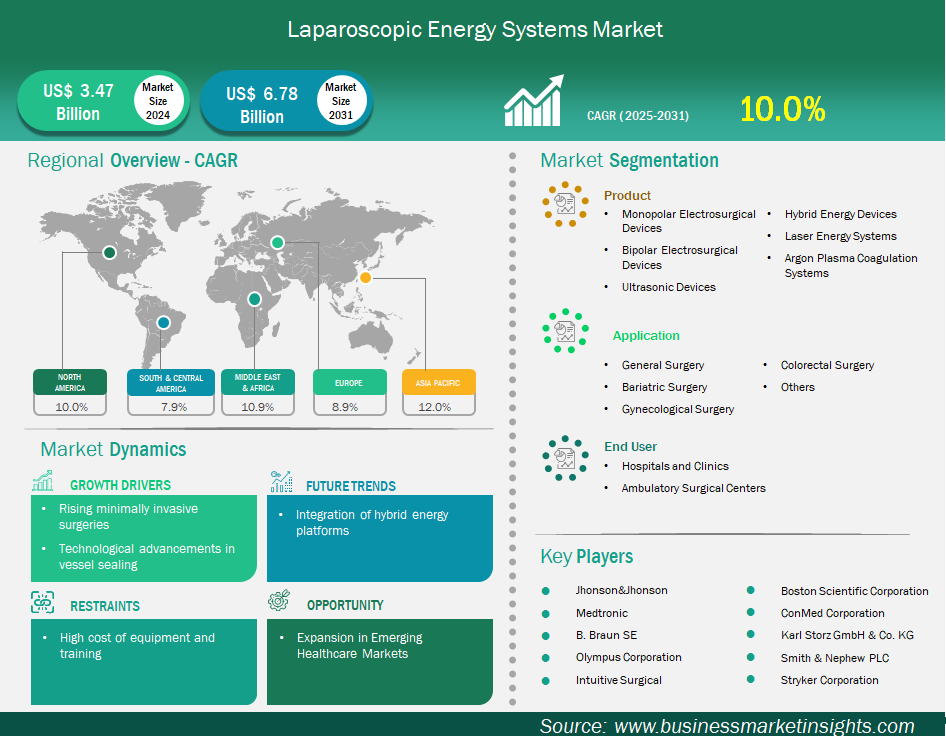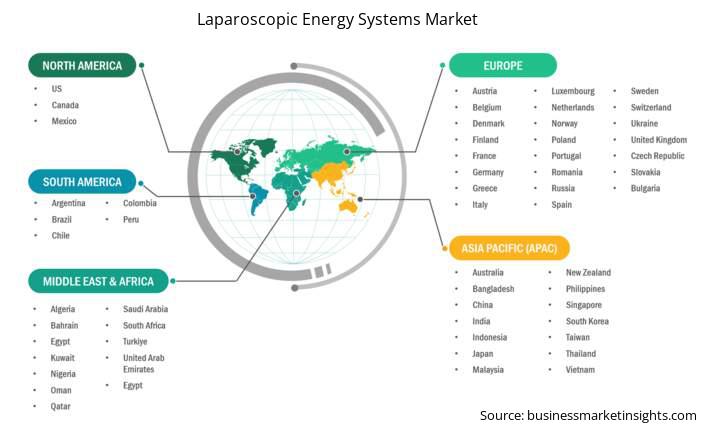Laparoscopic Energy Systems Market Outlook (2021-2031)
No. of Pages: 200 | Report Code: BMIPUB00031674 | Category: Life Sciences
No. of Pages: 200 | Report Code: BMIPUB00031674 | Category: Life Sciences
The laparoscopic energy systems market size is expected to reach US$ 6,780.29 million by 2031 from US$ 3,473.40 million in 2024. The market is estimated to record a CAGR of 10.0% from 2025 to 2031.
Executive Summary and Global Market Analysis:
The global laparoscopic energy systems market is experiencing significant growth driven by rising demand for minimally invasive surgeries, technological advancements in vessel sealing, and increased adoption in outpatient settings. Laparoscopic energy systems encompass monopolar electrosurgical devices, bipolar electrosurgical devices, ultrasonic devices, hybrid energy devices, laser energy systems, argon plasma coagulation systems. Energy systems are anticipated to see substantial growth, as a result of the existing technological advancements and faster clinical adoption. One usage of energy systems is expected to be found during 70—80% of all laparoscopic procedures. The advancements in electrosurgical devices include modes such as "cutting-coagulation" as well as the new electrosurgical generators that can auto-adjust the power output based on the specific type of tissue. Ultrasonic devices (such as Ethicon's Harmonic Scalpel) are emerging as the desired devices which allow for the closest dissection without thermal damage but also allows for cutting and coagulation simultaneously.
Key players Medtronic (with its LigaSure system) and Olympus Corporation (which launched its 5mm POWERSEAL Sealer/Divider devices in August 2024 as part of its advanced bipolar surgical energy product range) have made significant investments and product introductions. New RF devices (as of April 2025) have led to autonomous safety features (with automatic feedback) being added, which we hope means a safer device and more devices to choose from. This sort of innovation has led to safety and efficiency in electrosurgical devices which cuts into the potential benefits of minimally invasive surgery (i.e., reduced post-operative pain, recovery times, and complication risks), which facilitates energy systems as the next cornerstone of modern laparoscopic surgery.
Laparoscopic Energy Systems Market Strategic Insights

Laparoscopic Energy Systems Market Segmentation Analysis
Key segments that contributed to the derivation of the Laparoscopic Energy Systems market analysis are product, application, and end user.
Laparoscopic Energy Systems Market Drivers and Opportunities:
Technological Advancements in Vessel Sealing Driving Laparoscopic Energy Systems Market
The advancement in technology associated with vessel sealing has been one of the most important drivers in the laparoscopic energy systems market. Historically, achieving hemostasis during laparoscopic surgery has involved traditional hemostatic instruments, like sutures, clips, or conventional monopolar or bipolar electrosurgery alternatives, all of which present challenges, including increased operative time, potential for thermal spread, and inconsistent and/or unpredictable sealing. Newer advanced vessel sealing technologies, predominantly using bipolar radiofrequency (RF) and ultrasonic energy, have created opportunities for utilizing energy in a way which enables surgeons to have accurate control of the tissue effects, and depending solely on the advanced systems for effective hemostasis. This includes continuous integrated tissue feedback technology, such as that utilized in LigaSure, which constantly measures the impedance of the tissue ensuring optimum sealing potential, minimal thermal injury while improving consistency and safety of seala; modern devices are designed with as little lateral thermal spread as possible, which enables only the tissue being treated to be exposed to energy, while avoiding thermal damage of any adjacent delicate structures, which can be critical in laparoscopy's confined spaces. Also notable is that the newer systems effectively seal relatively bigger vessels, up to 7mm diameter, which expands the number of procedures that a clinician could comfortably perform laparoscopically while still being confident in hemostasis; representation of power and also the benefits of multifunctionality is also noteworthy in regard to the integration of cutting mechanisms into the design delivering streamline workflow and success while shortening the time of the cases.
Current devices also present with superior ergonomic design features, including consideration given to utilizing wireless operational capabilities to ensure added comfort and enhanced movement to the surgeon for the procedure. Some current advanced systems that would fit into each category would include Salient, Medtronic, and Innasis, all of which utilize advanced designed and sophisticated application software.
Expansion in Emerging Healthcare Markets
The rapid expansion of healthcare markets in developing economies represents a tremendous opportunity for the laparoscopic energy systems market. There continue to be strong economic growth in countries within the Asia-Pacific, Latin American and African regions with rising disposable incomes and increasing healthcare expenditure. As individuals' income rises, their expectations for quality medical services and better medical treatments, including minimally invasive surgical procedures, also increases. In addition, regional governments continue to spend money on projects to improve healthcare infrastructure; to build new hospitals, improve older hospitals and create policies that improve access to modern medical devices.
Additionally, there is an increasing awareness amongst patients and medical professionals in developing economies of the benefits of minimally invasive surgery, such as less pain, smaller incisions, shorter hospital stays, less recovery time, and fewer complications compared to open surgeries. The rising prevalence of chronic conditions such as obesity, cancer, and any type of cardiovascular disease that requires surgeons to operate also increases the demand for modern laparoscopic procedures. Although high upfront costs for laparoscopic equipment exist, as well as the need for training on poorly understood systems, the long-run economic benefits and patient outcomes associated with minimizing patient post-operative care supports future interest in minimally invasive surgeries. As healthcare providers want to provide world standards of care, concentrating on new laparoscopy techniques that are less traumatic is increasingly appealing.
Laparoscopic Energy Systems Market Size and Share Analysis
The laparoscopic energy systems market is classified according to products into monopolar electrosurgical devices, bipolar electrosurgical devices, ultrasonic devices, hybrid energy devices, laser energy systems, argon plasma coagulation systems. The monopolar electrosurgical devices segment led the market in 2024 and beyond. These devices utilize a single active electrode at the surgical site to deliver high-frequency electrical current, which then passes through the patient's body to a dispersive return electrode (grounding pad) to complete the circuit. This mechanism allows for a broad range of tissue effects, including precise cutting, coagulation, desiccation, and fulguration, making them suitable for various surgical tasks in laparoscopy.
In terms of applications, the market is segmented into general surgery, bariatric surgery, gynecological surgery, colorectal surgery, others. The general surgery segment had the largest market share in 2024. Laparoscopy has become the standard of care for numerous general surgical operations, including cholecystectomy (gallbladder removal), appendectomy (appendix removal), hernia repair (inguinal, umbilical, etc.), and various colorectal and bariatric surgeries. The inherent benefits of laparoscopic techniques—such as reduced pain, smaller incisions, shorter hospital stays, and faster recovery—are highly desirable for these frequently performed procedures, leading to a high volume of general surgical cases utilizing energy systems for precise cutting, coagulation, and vessel sealing. The broad scope and high incidence of conditions treated by general surgeons ensure a continuous and significant demand for these advanced energy systems.
By end user, the market is segmented into hospitals and clinics, and ambulatory surgical centers. The hospitals and clinics segment held the largest share of the market in 2024. These institutions possess the necessary infrastructure, including operating rooms, specialized equipment, and trained surgical staff, to conduct complex laparoscopic interventions. Hospitals, in particular, handle a high volume of both elective and emergency surgeries, and they are equipped to manage potential complications, which is crucial for advanced surgical procedures. Additionally, the increasing adoption of minimally invasive techniques by hospitals and clinics to improve patient outcomes, reduce hospital stays, and enhance overall efficiency further solidifies their position as the dominant consumers of laparoscopic energy systems in the market.
Laparoscopic Energy Systems Market Report Highlights
Report Attribute
Details
Market size in 2024
US$ 3.47 Billion
Market Size by 2031
US$ 6.78 Billion
Global CAGR (2025 - 2031) 10.0%
Historical Data
2021-2023
Forecast period
2025-2031
Segments Covered
By Product
By Application
By End User
Regions and Countries Covered
North America
Europe
Asia-Pacific
South and Central America
Middle East and Africa
Market leaders and key company profiles
Laparoscopic Energy Systems Market Report Coverage and Deliverables
The "Laparoscopic Energy Systems Market Size and Forecast (2021–2031)" report provides a detailed analysis of the market covering below areas:
Laparoscopic Energy Systems Market Country and Regional Insights

The geographical scope of the laparoscopic energy systems market report is divided into five regions: North America, Asia Pacific, Europe, Middle East & Africa, and South & Central America. The Laparoscopic Energy Systems market in Asia Pacific is expected to grow significantly during the forecast period.
The Asia Pacific Laparoscopic Energy Systems market consists of China, Japan, India, South Korea, Australia, Bangladesh, New Zealand, Philippines, Singapore, Indonesia, Taiwan, Malaysia, Vietnam, and the Rest of Asia Pacific. Asia Pacific is quickly becoming the fastest growing region for laparoscopic energy systems with factors that are changing the healthcare change landscape. The region's emerging economies and growth in disposable income are providing access to more advanced medical treatments. Additionally, there has been a rise in public and private healthcare spending along with massive investments to upgrade healthcare infrastructure; new hospitals and surgical centers are being built to house state-of-the-art technologies. More importantly, there is a growing awareness and acceptance of minimally invasive surgical procedures, which have benefits: less pain, shorter hospital stays, and faster recovery times for patients. The patient demographic also appreciates the necessary transition from inpatient to patients undergoing surgery with the goal of quickly discharging to home, rather than a hospital. Healthcare systems desire the same outcomes all while modifying surgical procedures which recently deemed significant impairment with zero risk factors with finite cost surgery outcomes. The future of laparoscopic energy systems is highly influenced by the rising trends of prolonged disease states that are chronic (various cancers and lifestyle) and weight-related, leading to many surgical outcomes worsening or deteriorating a person's health and considering surgery options with laparoscopic.
When evaluating the country-specific geographic capabilities, China is the leading market for Asia Pacific and expected to exhibit the highest CAGR. China is experiencing a huge demand for minimally invasive surgeries due to the rapidly expanding large and aging population and, following the numbers of chronic disease populations. The government is actively promoting improved access to minimally invasive surgical increased affordability of medical devices.
Laparoscopic Energy Systems Market Research Report Guidance
Laparoscopic Energy Systems Market News and Key Development:
The laparoscopic energy systems market is evaluated by gathering qualitative and quantitative data post primary and secondary research, which includes important corporate publications, association data, and databases. A few of the key developments in the Laparoscopic Energy Systems market are:
Key Sources Referred:
The Laparoscopic Energy Systems Market is valued at US$ 3.47 Billion in 2024, it is projected to reach US$ 6.78 Billion by 2031.
As per our report Laparoscopic Energy Systems Market, the market size is valued at US$ 3.47 Billion in 2024, projecting it to reach US$ 6.78 Billion by 2031. This translates to a CAGR of approximately 10.0% during the forecast period.
The Laparoscopic Energy Systems Market report typically cover these key segments-
The historic period, base year, and forecast period can vary slightly depending on the specific market research report. However, for the Laparoscopic Energy Systems Market report:
The Laparoscopic Energy Systems Market is populated by several key players, each contributing to its growth and innovation. Some of the major players include:
The Laparoscopic Energy Systems Market report is valuable for diverse stakeholders, including:
Essentially, anyone involved in or considering involvement in the Laparoscopic Energy Systems Market value chain can benefit from the information contained in a comprehensive market report.